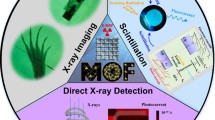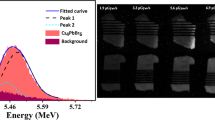Abstract
Gamma rays, as hazardous nuclear radiation, necessitate effective and rapid detection methods. This paper introduces a low-cost, fast, and simple fluorescence method based on CdTe/CdS core/shell quantum dots for gamma-ray detection. CdTe/CdS quantum dots, subjected to gamma irradiation from a 60Co source under various conditions, were investigated to assess their fluorescence sensor capabilities. The obtained results showed that an increase in CdTe/CdS nanoparticle size was associated with decreased sensitivity, while a reduction in CdTe/CdS concentration correlated with increased sensitivity. To further validate the practicality of CdTe/CdS core/shell quantum dots in gamma-ray detection, the structural properties of the quantum dots were meticulously studied. Raman spectroscopy, X-ray diffraction (XRD), and Fourier-transform infrared (FT-IR) analysis were conducted before and after gamma-ray radiation. The results demonstrated the crystalline stability of CdTe/CdS core/shell quantum dots under gamma irradiation, highlighting their robust structural integrity. In conclusion, the experimental findings underscore the exceptional potential of CdTe/CdS quantum dots as an off-fluorescence probe for simple, low-cost, fast, and on-site detection of gamma rays. This research contributes to the advancement of efficient and practical methods for gamma-ray sensing in various applications.










Similar content being viewed by others
Data Availability
No datasets were generated or analysed during the current study.
References
McNamara NP, Black HIJ, Beresford NA, Parekh NR (2003) Effects of Acute Gamma Irradiation on Chemical, Physical and Biological properties of soils. Appl Soil Ecol 24:117–132. https://doi.org/10.1016/S0929-1393(03)00073-8
Jan S, Parween T, Siddiqi TO, Mahmooduzzafar X (2012) Effect of Gamma Radiation on Morphological, Biochemical, and Physiological Aspects of Plants and Plant Products. 20:17–39. https://doi.org/10.1139/a11-021
Ianuzzi A, Kurtz SM (2008) Sterilization of joint replacement technology. Jt Replace Technol 407–427. https://doi.org/10.1533/9781845694807.3.407
Farahmandzadeh F, Molaei M, Alehdaghi H (2023) Application of CdTe/ZnS Core/Shell Quantum Dots as on Fluorescence Sensor for Detection of Gamma Rays. J Fluoresc 33:2361–2367. https://doi.org/10.1007/S10895-023-03242-Y/METRICS
Wolfbeis OS (2005) Materials for fluorescence-based Optical Chemical sensors. J Mater Chem 15:2657–2669. https://doi.org/10.1039/B501536G
Rajasekar M, Ranjitha V, Rajasekar K (2023) Recent advances in fluorescent-based cation sensors for Biomedical Applications. Results Chem 5:100850. https://doi.org/10.1016/J.RECHEM.2023.100850
Farahmandzadeh F, Salehi S, Molaei M, Fallah H, Nejadshafiee V (2023) Facile Synthesis, Application as Off Fluorescent Sensor for Detection of Lead (Pb2+) Ions and Catalyst for Degradation of Dyes from Water. J Fluoresc 33:1515–1524. https://doi.org/10.1007/S10895-023-03157-8/METRICS. CdS Semiconductor Quantum Dots
Carter KP, Young AM, Palmer AE (2014) Fluorescent sensors for Measuring Metal ions in Living systems. Chem Rev 114:4564–4601. https://doi.org/10.1021/CR400546E/ASSET/IMAGES/LARGE/CR-2013-00546E_0002.JPEG.
Gaviria-Arroyave MI, Cano JB, Peñuela GA (2020) Nanomaterial-based fluorescent biosensors for Monitoring Environmental pollutants: a critical review. Talanta Open 2:100006. https://doi.org/10.1016/J.TALO.2020.100006
Ashley J, Manikova PF, Sensors (2023) Fundam Sens Technol Princ Nov Des 147–161. https://doi.org/10.1016/B978-0-323-88431-0.00022-3
Bidmanova S, Kotlanova M, Rataj T, Damborsky J, Trtilek M, Prokop Z (2016) Fluorescence-based Biosensor for Monitoring of Environmental pollutants: from Concept to Field Application. Biosens Bioelectron 84:97–105. https://doi.org/10.1016/J.BIOS.2015.12.010
Molaei M, Farahmandzadeh F, Hemmati R (2022) Mercury (Hg2+) detection in Aqueous Media, Photocatalyst, and Antibacterial applications of CdTe/ZnS Quantum dots. J Fluoresc 32:2129–2137. https://doi.org/10.1007/S10895-022-03013-1/METRICS
Bowyer AA, New EJ (2023) Fluorescent platforms for environmental sensing. Fluoresc Chemosens 378–405. https://doi.org/10.1039/9781839167324-00378
Farahmandzadeh F, Molaei M, Alehdaghi H, Karimipour M (2022) The significant increasing photoluminescence Quantum Yield of the CdTe/CdS/ZnS Core/Multi-Shell Quantum Dots (QDs) by 60Co Gamma Irradiation. Appl Phys Mater Sci Process 128:1–10. https://doi.org/10.1007/S00339-022-05390-7/METRICS
Oliveira NM, Medeiros AD (2021) Barboza Da Silva, C. Hormetic effects of Low-Dose Gamma Rays in soybean seeds and seedlings: a detection technique using Optical sensors. Comput Electron Agric 187:106251. https://doi.org/10.1016/J.COMPAG.2021.106251. NogueiraM.de L.; Arthur, V.; Mastrangelo, T. de
Alehdaghi H, Assar E, Azadegan B, Baedi J, Mowlavi AA (2020) Investigation of Optical and Structural Properties of Aqueous CdS Quantum Dots under Gamma Irradiation. Radiat Phys Chem 166:108476. https://doi.org/10.1016/J.RADPHYSCHEM.2019.108476
Chang S, Wu X, Lan J, Li Z, Zhang X, Zhang H (2019) γ-Radiation enhanced luminescence of Thiol-Capped Quantum dots in Aqueous Solution. Nanomaterials 9. https://doi.org/10.3390/NANO9040506
Vaishanav SK, Korram J, Pradhan P, Chandraker K, Nagwanshi R, Ghosh KK, Satnami ML (2017) Green Luminescent CdTe Quantum dot based fluorescence Nano-Sensor for Sensitive Detection of Arsenic (III). J Fluoresc 27:781–789. https://doi.org/10.1007/S10895-016-2011-0/METRICS
Xia YS, Zhu CQ (2008) Use of Surface-modified CdTe Quantum dots as fluorescent probes in sensing Mercury (II). Talanta 75:215–221. https://doi.org/10.1016/J.TALANTA.2007.11.008
Ding X, Qu L, Yang R, Zhou Y, A Li J (2015) Highly selective and simple fluorescent sensor for Mercury (II) Ion Detection based on cysteamine-capped CdTe Quantum dots synthesized by the Reflux Method. Luminescence 30:465–471. https://doi.org/10.1002/BIO.2761
Farahmandzadeh F, Molaei M, Karimipour M, Shamsi AR (2020) Highly luminescence CdTe/ZnSe core–Shell QDs; synthesis by a simple low temperature Approach. J Mater Sci Mater Electron 31:12382–12388. https://doi.org/10.1007/S10854-020-03784-Y/METRICS
Wu S, Dou J, Zhang J, Zhang SA (2012) Simple and Economical One-Pot Method to Synthesize High-Quality Water Soluble CdTe QDs. J Mater Chem 22:14573–14578. https://doi.org/10.1039/C2JM31409F
Yong KT, Law WC, Roy I, Jing Z, Huang H, Swihart MT, Prasad PN (2011) Aqueous phase synthesis of CdTe Quantum dots for Biophotonics. J Biophotonics 4:9–20. https://doi.org/10.1002/JBIO.201000080
He R, You X, Tian H, Gao F, Cui D (2008) Synthesis of CdTe Colloidal Quantum Dots (QDs) in water. Front Chem China 3:325–329. https://doi.org/10.1007/S11458-008-0053-9/METRICS
Liu YF, Yu JS (2009) Selective synthesis of CdTe and high luminescence CdTe/CdS Quantum dots: the Effect of ligands. J Colloid Interface Sci 333:690–698. https://doi.org/10.1016/J.JCIS.2009.01.008
Chen J, Xiao A, Zhang Z, Yu Y, Yan Z (2015) The synthesis and modification of CdTe/CdS Core Shell Quantum Dots. Spectrochim Acta Part Mol Biomol Spectrosc 151:506–509. https://doi.org/10.1016/J.SAA.2015.06.124
Liu YF, Xie B, Yin ZG, Fang SM, Zhao JB (2010) Synthesis of Highly Stable CdTe/CdS Quantum Dots with Biocompatibility. Eur. J. Inorg. Chem. 2010, 1501–1506, https://doi.org/10.1002/EJIC.200900978
Pourtakallo SN, Molaei M, Khanzadeh M (2023) CdTe/CdS core–Shell Quantum dots: synthesis and applications as a Heavy Metal Ion’s fluorescence Sensor and Photocatalyst for Photodegradation of Organic dyes. Phys Status Solidi 220. https://doi.org/10.1002/PSSA.202200858
Farahmandzadeh F, Molaei M, Alehdaghi H, Karimipour M, Shamsi A (2022) Effect of concentration and Shell Thickness on the Optical Behavior of Aqueous CdTe/ZnSe Core/Shell Quantum Dots (QDs) exposed to Ionizing Radiation. Luminescence 37:431–439. https://doi.org/10.1002/bio.4189
Stodilka RZ, Carson JJL, Yu K, Md. BZ, Li C, Wilkinson D (2009) Optical degradation of CdSe/ZnS Quantum dots upon Gamma-Ray Irradiation. J Phys Chem C 113:2580–2585. https://doi.org/10.1021/JP808836G
Molaei M, Farahmandzadeh F, Mousavi TS, Karimipour M (2022) Photochemical synthesis, Investigation of Optical Properties and Photocatalytic activity of CdTe/CdSe Core/Shell Quantum Dots. Mater Technol 37:1818–1824. https://doi.org/10.1080/10667857.2021.1988040
Funding
No funding.
Author information
Authors and Affiliations
Contributions
All authors contributed to the study’s conception and design. Material preparation, data collection, and analysis were performed by Farzad Farahmandzadeh, Elham Molahosseini, Somayeh Naseri Portakaloo, Mehdi Molaei, and Mohammad Khanzadeh. The first draft of the manuscript was written by Farzad Farahmandzadeh. All authors read and approved the final manuscript.
Corresponding author
Ethics declarations
Ethics Declaration Statement
This work was done in the nanoscience lab of the Vali-e-Asr University of Rafsanjan, Iran, this article is original, this article has been written by the stated authors who are ALL aware of its content and approve its submission. This article has not been published previously.
Consent to Participate
This article has been written by the stated authors who are ALL aware of its content and approve its submission.
Consent for Publication
This study doesn’t contain any data from a person.
Competing Interests
The authors declare no competing interests.
Additional information
Publisher’s Note
Springer Nature remains neutral with regard to jurisdictional claims in published maps and institutional affiliations.
Rights and permissions
Springer Nature or its licensor (e.g. a society or other partner) holds exclusive rights to this article under a publishing agreement with the author(s) or other rightsholder(s); author self-archiving of the accepted manuscript version of this article is solely governed by the terms of such publishing agreement and applicable law.
About this article
Cite this article
Farahmandzadeh, F., Molahosseini, E., portakaloo, S.n. et al. Efficient Gamma Ray Detection Using CdTe/CdS Core/Shell Quantum Dots: A Simple and Rapid Fluorescence Approach. J Fluoresc (2024). https://doi.org/10.1007/s10895-024-03630-y
Received:
Accepted:
Published:
DOI: https://doi.org/10.1007/s10895-024-03630-y




